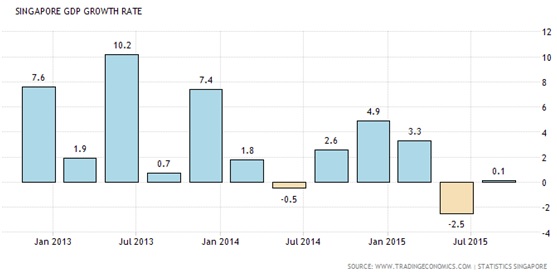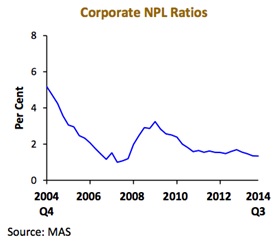Recession is coming: How can Property Loans help SMEs?
Table of Contents
Singapore has narrowly averted a technical recession. While a recession has been averted, the PMI is below 50%, indicating a contraction in manufacturing sector.
Chart 1: Purchasing Manager’s Index (PMI), Singapore Institute of Purchasing and Materials Management (SIPMM), Reference 1.
Another measure of recession that some economists suggested is not simply looking at GDP figures (demand), but by looking at dropping income levels as well as rising unemployment rate. Many enterprises can sustain short-term drop in demand and may not immediately retrench people, hence leaving the purchasing power largely intact.
 Chart 2: Singapore Quarterly GDP Growth rate (TradingEconomics, SingStats)
Chart 2: Singapore Quarterly GDP Growth rate (TradingEconomics, SingStats)
Singapore’s SME makes up 99% of all enterprises, employ 66% of the workforce and accounts for 48% of the GDP. SMEs are defined as having revenues of less than $100m and with staff of less than 200. (Singstat, Reference 2)
A drop off in demand means that companies are hardly growing their top lines and may go into the red. This is especially true for SMEs with less than $10m in revenues.
Singapore’s corporate default rate of Corporations listed on SGX is below 2%.
(Financial Stability Review, MAS, Reference 3). SMEs could see a higher default rate at 3 to 4%.
Chart 3: Corporate NPL Ratio, Financial Stability Review 2014, MAS, Reference 3
In 2008, access to capital and funding by Singapore’s SME was constricted. This led the government to, “Enhance the various Government schemes that are in place to help our Small and Medium Sized Enterprises (SMEs) retain access to credit. Most of these schemes involve Government risk-sharing with the banks on loans to SMEs.” (Excerpt, Helping SMEs retain access to credit, Parliamentary replies, Reference 4)
In short, this means that the banks cut back on SME lending exposure due to potential higher Non-performing loan risks. Hence funds will likely dry up during uncertain financial periods when SMEs will need them most. It is safe to say that SMEs will be exposed to elevated funding disruption risks, increased cost of funding during recessionary periods. Hence SMEs need to take action now to secure funding.
Future Interest Rate Trends – By Looking at the Bond Yield Curve
The bond yield curve gradient has become less steep, indicating slower growth. There is also higher mid and long term interest rate expectations indicating inflation expectations or simply a higher interest rate environment. The 20-year Bond is currently at 2.9%.
Chart 4: Singapore Bond Yield Curve End 2014 versus Nov 2015, Asian Development Bank, Reference 5
Outstanding corporate bonds in Singapore by listed companies are estimated at $128 billion. Recent 1Q2015 bond issuers such as Singtel 5.5 year and 6.5 years coupon of 2.58% and 2.72% respectively while Mapletree commercial trust’s 8 years bond has a coupon of 3.25%. UOB’s bond with maturity at 03 Sep 2019 gives a coupon of 5.375%.
Table 1: Singapore Government Securities Benchmark Yield, Reference 6
Table 2: Singapore Corporate bonds and business term loan rates, ADB, Spring, iCompareLoan.com, Reference 7.
As there is a credit spread between Risk Free rate (Government bonds) versus the corporates, the interest rates and borrowing cost reflects that risk. SMEs will have a even bigger credit spread versus the risk free rate, hence the unsecured Business Term Loan rates are usually in the 10+ % range, depending on loans size as well as tenure.
Hierarchy of Borrowing Costs: Secured versus Unsecured Loan
The impending weakness in the economic growth poses more risks to SME than to large corporations.
However the level of financial literacy in SMEs, especially the smaller ones is usually not so strong, such that SMEs usually ended up with a higher cost of funds structure.
Secured lending refers to lending in which an asset is pledged. (I.e. Pawn shop, you pledge your Rolex which is worth $10,000 and Pawnshop will lend you $6,000 @ 1% interest a month) Secured lending presents less risk to the lender and hence charges lower interest rates.
Unsecured lending does not require pledged assets. Hence this presents greater risk to lenders and hence are more expensive. Businesses have under-utilized secured loans as small businesses usually have nothing to secure against.
There are many types of secured and unsecured loans (Reference 8), secured loan is the cheapest form of borrowing. However many businesses use the most expensive type of borrowing, Selling Equity, followed by Factoring (invoice discounting), followed by business term loan and line of credit.
Micro Loan Program by Spring Singapore is also a good source of funding, however not so many companies qualify, for those who qualify, they may not be able to obtain the maximum $100,000 loan. Interest cost starts from 5.5% with up to 4 years tenure. (Reference 9)
However many small companies do not qualify for the full $100,000, while many SMEs are owned by families or husband and wife teams in operation for many years and exceed the 3 year rule.
Problems faced by SMEs
Wrong Corporate structure
Many SMEs may not have the right financing or salary structure. These bosses tend to under-declare their incomes and instead declare dividends. Whilst this reduces their taxable income, with the new Total debt servicing ratio (TDSR) rule, this also impedes many SME bosses from buying their homes. For SME bosses who already have their homes, low incomes may also sometime limit the amount of funds they can borrow despite the positive cash flow from the business.
Squeezed Gross Margins
Many businesses have gross margins that are already squeezed having to compete against China, India and newer economies. In Singtel’s 2015 financial report, it reported Operating revenues of $17,222.9m, while earnings after operating expenses (before tax, interest and amortisation) are $5,090.7m.
It’s selling and admin costs are $4,000.9m, Staff costs are $2,461.1m, cost of equipment sold $2,147.3m, Repairs and maintenance $339.3m and other cost of sales $786.5m. This indicated an EBITDA margin of ~29.6%.
And to put it bluntly, this is a company who is either a tripoly or a duopoly in various business segments it competes in, and have substantial pricing power. This is a very good result, how many SMEs can aspire to these kind of results?
Faced with borrowing costs in the mid 10%, labour cost in the 5 to 10% of revenue and operating costs which could take up another 5 to 15% of revenue, these businesses need a gross margin in excess of 30% just to break even. Depending on industries, not many industries can offer gross margins in excess of 30%. Hence SMEs are especially sensitive to top line growth for those with 20+ to 40% gross margins. This means that a drop in demand hurts them more than an increase in cost. While those SMEs with gross margins less than 10% are especially susceptible to increases in fixed costs as they are unlikely to be able to raise prices.
Rising cost of funds
Cost of funds are expected to rise by interpreting the spot bond yield curve rates. Underlying influence may be due to impending US Fed funds target rate hike as US unemployment is in Oct 2015 is now at 5%. (Read Full story here on Mortgage Interest Rate trends, Reference 10) With market uncertainty, access to funds for SMEs could be even more restricted in the coming 1 to 2 years.
How can SMEs overcome high cost of funding issues?
SME bosses should start to realise that under-declaration of income impedes borrowing and start to rectify this situation to reflect their true income. While it is important to have a tax efficient salary structure using a combination of Salary, Director fees and dividends, it is worth it to review this to be eligible for adequate funding.
Business gross margins are largely determined by the level of competition in established business sectors. In short, the largest determinants of whether a SME will make money or not is, labour, rentals and cost of funds. If you are Singtel or CapitalMall, you have access to cheap capital at 2.5 to 3.5% and you select an industry segment with a reasonable gross margin, you will almost always make money in any business provided you do not mess up too badly.
But SMEs, especially those directors who are currently in their late 30s and early 40s who have bought their own residential homes, they could be sitting on tied up equity in their properties. Residential home loan rates are around 2%. They could free up this capital and invest prudently in their own business. With this reduced cost of funding, the business owners could immediately save ~10% off borrowing costs.
Case Study: SME owned by 2 Directors and 3 Shareholders
Why would I borrow on my residential home for a company which I’m only one of the many directors?
There were 2 directors and 3 shareholders. 2 Directors owned 35% each, with the rest of the shareholders each holding 10%.
Funds needed: $500,000 (for business expansion)
We advised the firm to structure a Director’s resolution to approve the company to request for Director Loan to company at 5% interest rate. The 2 major shareholders cum directors hold 70% shares, hence are allotted $350,000. Shareholders or directors who do not wish to lend to company at the approved 5% interest rate may give up their allotment. Unused allotment may be used by other directors/shareholders equally.
These 2 major shareholders recently took out a Refinance of their residential property loan with cash out (equity term loan) of $400,000 at 1.8%. They then lend their company $400,000 at 5% interest, making a decent return on their loan to their own company. Another 2 shareholder took up their allotment and lent the company $100,000 at 5%.
In this way, the company has access to cheaper capital, boosting it’s survival and yet create a fair debt structure for all directors and/or shareholders to participate. Its similar to some kind of preferential bonds where only directors and shareholders can participate in.
SUMMARY
SMEs can get their personal income structure right with the optimal balance of tax efficiency as well as sufficient income for borrowing capacity.
Business niches are increasingly hard to find, most businesses do not find “blue ocean” to execute on. In the interim, these businesses are confined by the Red Ocean and are squeezed at the top line pricing (margins squeezed) and bottom line (Rising Fixed costs). The major cost factors are labour and rental. For those SME that are thinking to expand, they are faced with Cost of Funds, Labour and Rental costs.
SMEs should leverage on their cheaper secured mortgages to free up equity from their house to lower their business borrowing costs by structuring Director Loan to company.
In order to lock in low rates from residential property equity loan (cash out), it might be safer for SME bosses to consider a 3 years to 5 years fixed rate structure to hedge against rising interest rates.
For innovative and growing companies, investors with at least $300,000 of spare cash could also get in on the game (to bridge the gap left behind by banks) to lend to growing companies who can afford to pay 14 to 18% per annum in interest costs. Default rates are carefully managed using some of the same tools used by the banks and credit processes to assess risks. Even if default rates are double that of large companies, that is still less than 4%. We could structure some convertible loans where investors can partake in the upside should the company get bought over, while drawing a net return of 10 to 14% per annum.
REFERENCES
1. Purchasing manager’s Index, SIPMM, http://www.sipmm.edu.sg/images/PMI/BB2015-10-1P.pdf
2. Singapore SME valued added and employment by SME, Singstat, http://www.singstat.gov.sg/docs/default-source/default-document-library/statistics/visualising_data/singapore-economy16072015.pdf
3. Financial Stability Review 2014, MAS, http://www.mas.gov.sg/~/media/resource/publications/fsr/FSR%202014.pdf
4. Excerpt, Helping SME retain access to credit, Parliamentary replies,
“5. Our banks make these assessments carefully, and take into account both the short-term risks and their long term interests in keeping their customers. We should continue to leave these decisions to them. However, what Government can and will do is to enhance the various Government schemes that are in place to help our Small and Medium Sized Enterprises (SMEs) retain access to credit. Most of these schemes involve Government risk-sharing with the banks on loans to SMEs.”
http://www.mas.gov.sg/news-and-publications/parliamentary-replies/2008/reply-to-pq-on-banks-lending-to-businesses-and-in-particular-to-the-building-contractors-and-their-suppliers.aspx
5. Singapore Bond Yield Curve Nov 2015, Asian Development Bank, https://asianbondsonline.adb.org/singapore/data/marketwatch.php?code=government_bond_yields
6. Singapore Government Securities Benchmark Yield, https://secure.sgs.gov.sg/fdanet/SgsBenchmarkIssuePrices.aspx
7. Singapore Corporate bonds and business term loan rates, ADB, Spring, iCompareLoan.com
https://asianbondsonline.adb.org/singapore/market_summary/sg_market_summary_201506.pdf
8. Types of Secured and unsecured loans: –
• Mortgage home loan
• Mortgage commercial and industrial property loan
• Bridging Loan
• Construction loan
• Term loan
• Car loan
• Secured overdraft
• Secured credit card
• Factoring
• Equipment loan
Some of the types of unsecured loans are: –
• Education loan (personal)
• Renovation loan
• Personal loan
• Overdraft (Unsecured)
• Credit card
• Term loan
• Charge card
• Line of credit
9. Spring Singapore offers micro loans of up to $100,000 for companies with less than 10 employees or has annual sales of less than $1m with at least 30% local shareholding and company’s group annual sales of less than $100m and less than 200 employees. These companies need to be less than 3 years old, hence very few companies qualify.
http://www.spring.gov.sg/Growing-Business/Loan/Pages/micro-loan-programme.aspx
10. Mortgage Interest Rate Trends, https://www.icompareloan.com/resources/singapore-mortgage-interest-rate-trends/
For advice on a personal loan.
For advice on a new home loan.
For refinancing advice.
Download this article here.











